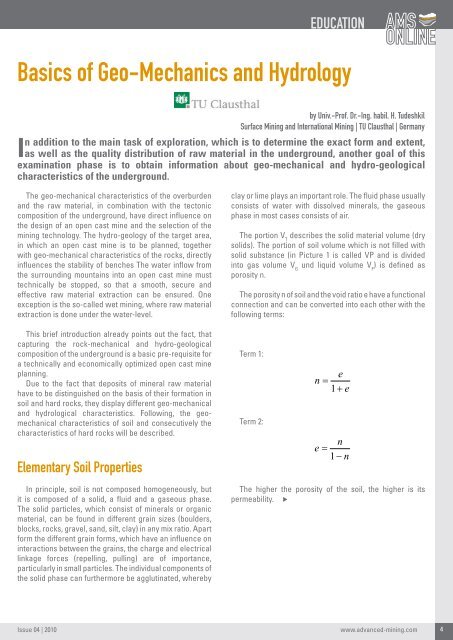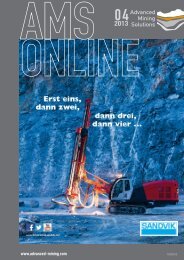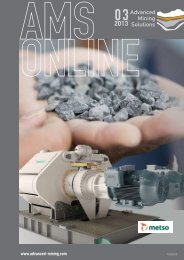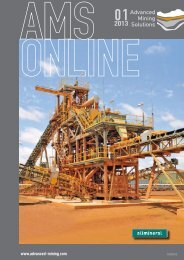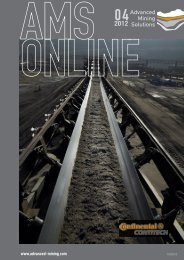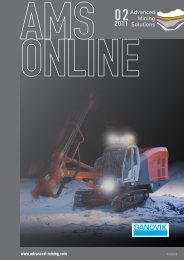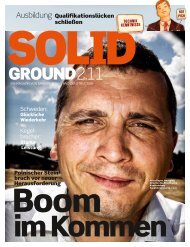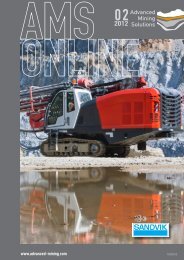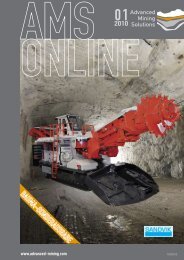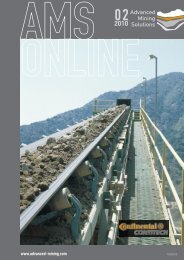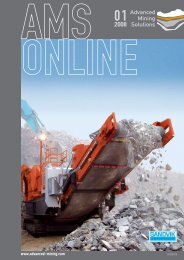A new face drilling rig for narrow tunnels and ... - Advanced Mining
A new face drilling rig for narrow tunnels and ... - Advanced Mining
A new face drilling rig for narrow tunnels and ... - Advanced Mining
Create successful ePaper yourself
Turn your PDF publications into a flip-book with our unique Google optimized e-Paper software.
EDUCATION<br />
Basics of Geo-Mechanics <strong>and</strong> Hydrology<br />
by Univ.-Prof. Dr.-Ing. habil. H. Tudeshkil<br />
Sur<strong>face</strong> <strong>Mining</strong> <strong>and</strong> International <strong>Mining</strong> | TU Clausthal | Germany<br />
In addition to the main task of exploration, which is to determine the exact <strong>for</strong>m <strong>and</strong> extent,<br />
as well as the quality distribution of raw material in the underground, another goal of this<br />
examination phase is to obtain in<strong>for</strong>mation about geo-mechanical <strong>and</strong> hydro-geological<br />
characteristics of the underground.<br />
The geo-mechanical characteristics of the overburden<br />
<strong>and</strong> the raw material, in combination with the tectonic<br />
composition of the underground, have direct influence on<br />
the design of an open cast mine <strong>and</strong> the selection of the<br />
mining technology. The hydro-geology of the target area,<br />
in which an open cast mine is to be planned, together<br />
with geo-mechanical characteristics of the rocks, directly<br />
influences the stability of benches The water inflow from<br />
the surrounding mountains into an open cast mine must<br />
technically be stopped, so that a smooth, secure <strong>and</strong><br />
effective raw material extraction can be ensured. One<br />
exception is the so-called wet mining, where raw material<br />
extraction is done under the water-level.<br />
This brief introduction already points out the fact, that<br />
capturing the rock-mechanical <strong>and</strong> hydro-geological<br />
composition of the underground is a basic pre-requisite <strong>for</strong><br />
a technically <strong>and</strong> economically optimized open cast mine<br />
planning.<br />
Due to the fact that deposits of mineral raw material<br />
have to be distinguished on the basis of their <strong>for</strong>mation in<br />
soil <strong>and</strong> hard rocks, they display different geo-mechanical<br />
<strong>and</strong> hydrological characteristics. Following, the geomechanical<br />
characteristics of soil <strong>and</strong> consecutively the<br />
characteristics of hard rocks will be described.<br />
Elementary Soil Properties<br />
In principle, soil is not composed homogeneously, but<br />
it is composed of a solid, a fluid <strong>and</strong> a gaseous phase.<br />
The solid particles, which consist of minerals or organic<br />
material, can be found in different grain sizes (boulders,<br />
blocks, rocks, gravel, s<strong>and</strong>, silt, clay) in any mix ratio. Apart<br />
<strong>for</strong>m the different grain <strong>for</strong>ms, which have an influence on<br />
interactions between the grains, the charge <strong>and</strong> electrical<br />
linkage <strong>for</strong>ces (repelling, pulling) are of importance,<br />
particularly in small particles. The individual components of<br />
the solid phase can furthermore be agglutinated, whereby<br />
clay or lime plays an important role. The fluid phase usually<br />
consists of water with dissolved minerals, the gaseous<br />
phase in most cases consists of air.<br />
The portion V T describes the solid material volume (dry<br />
solids). The portion of soil volume which is not filled with<br />
solid substance (in Picture 1 is called VP <strong>and</strong> is divided<br />
into gas volume V G und liquid volume V F ) is defined as<br />
porosity n.<br />
The porosity n of soil <strong>and</strong> the void ratio e have a functional<br />
connection <strong>and</strong> can be converted into each other with the<br />
following terms:<br />
Term 1:<br />
Term 2:<br />
e<br />
n =<br />
1+<br />
e<br />
n<br />
e =<br />
1−<br />
n<br />
The higher the porosity of the soil, the higher is its<br />
permeability.<br />
Issue 04 | 2010 www.advanced-mining.com<br />
4


